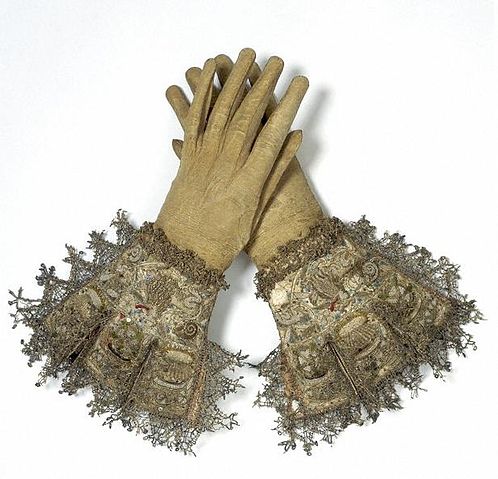
File:Glovesvanda.jpg

Summary
Pair of gloves, 1603-1625 V&A Museum no.1506&A-1882
Techniques - Leather and satin, embroidered with silk and metal thread, spangles and seed pearls
Artist/designer - Unknown
Place - England
Dimensions - Height 9 cm (maximum, at lace cuffs) Width 26 cm (maximum) Length 41.5 cm (maximum)
Object Type - Gloves served several purposes in early 17th-century England. Many were solely decorative, to display the wealth and status of their owner. They were worn in the hat or belt, as well as carried in the hand. Gloves were popular as gifts and were often given by a young gallant to his favourite mistress. In combat, a glove was thrown down as a gage, or challenge.
Materials & Making - Seed pearls decorate this very richly embellished glove. Silver and silver-gilt thread and purl (short lengths of metal thread curled tightly together like a minute spring), spangles (an old term for sequins) and coloured silks cover the densely embroidered satin gauntlet. Each motif is heavily padded underneath with additional stitches to give a pronounced three-dimensional effect.
Subjects Depicted - A snail, a lion and a sheep are embroidered on the gloves. These animals may relate to the heraldry of the owner. They could also be personal devices of the wearer, chosen to represent some individual quality or virtue. Many of the motifs that appear in Jacobean embroidery were copied from emblem books. This was a popular form of literature, which linked visual images with moral virtues.
Source: http://collections.vam.ac.uk/item/O77421/pair-of-gloves/
Licensing
| This work is licensed under the Creative Commons Attribution-ShareAlike 3.0 License. This licensing tag was added to this file as part of the GFDL licensing update. |
 |
This is a candidate to be copied to Wikimedia Commons. Freely licensed or public domain media are more accessible to other Wikimedia projects if placed on Commons. Any user may perform this move—please see Moving images to the Commons for more information. Please thoroughly review the copyright status of this file and ensure that it is actually eligible for transfer to Commons. If you are concerned that this file could have problems with its attribution information and/or copyright status, then remove this notice and DO NOT transfer it to Commons. By transferring this file to Commons, you acknowledge you have read this message and are willing to accept any and all consequences for inappropriate transfers. Repeat violators will be blocked from editing. If you have checked the file and it is OK to move to Commons add "|human=username" to the template so other users can see it has been checked and can help you copy the file to Commons. If the file can't be moved to Commons consider nominating the file for deletion or changing the template to {{NotMovedToCommons|reason=Why it can't be copied to Commons}} If this image has been copied to Commons replace this tag with {{subst:ncd}} or {{subst:ncd|Image name on Commons.ext}} if a different filename is used on Commons. Copy to Commons: via CommonsHelper |
||
|
|||
File usage
More information
SOS Children chose the best bits of Wikipedia to help you learn. SOS Childrens Villages is a global charity founded in 1949 to give children who have lost everything the childhood they deserve. There are many ways to help with SOS Childrens Villages.

